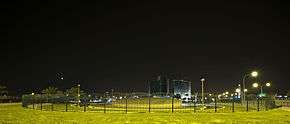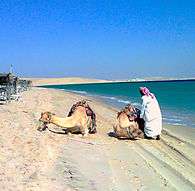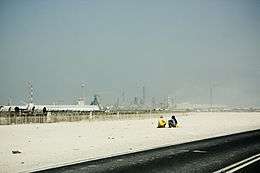Mesaieed
| Mesaieed مسيعيد | |
|---|---|
| City | |
 Map of Qatar with Al Wakrah municipality highlighted | |
| Coordinates (Umm Sa'id): 24°59′N 51°33′E / 24.98°N 51.55°ECoordinates: 24°59′N 51°33′E / 24.98°N 51.55°E | |
| Country |
|
| Municipality | Al Wakrah Municipality |
| Established | 1949 |
| Area | |
| • Total | 154.7 km2 (59.7 sq mi) |
| Population (2010) | |
| • Total | 35,150[1][2] |
| Time zone | East Africa Time (UTC+03) |
| ISO 3166 code | QA |
Mesaieed (Arabic: مسيعيد, also transliterated as Musay'id and Umm Sa'id) is an industrial city in Al Wakrah Municipality in the State of Qatar, approximately 50 kilometres (31 mi) south of Doha. It was one of the most important cities in Qatar during the 20th century, having gained in recognition as a prime industrial zone and tanking center for petroleum received from Dukhan.[3]
Both Mesaieed and its industrial area are administered by a subdivision of Qatar Petroleum called "Mesaieed Industry City Management", which was established in 1996.[4]
History
Mesaieed was established in 1949 as a tanker terminal by Qatar Petroleum on a previously uninhabited site along the coast. It was chosen by the company because of its proximity to the working population in Doha and Al Wakrah and because of the depth of its waters.[5] It was the only deepwater port in Qatar for more than 20 years.[6]
It was administered wholly by Qatar Petroleum at the time of its inception. After Qatar Petroleum transferred its headquarters from Dukhan to Mesaieed in 1956, they undertook substantial development on workers' camps and facilities.[7] The government had agreed to the company's request to allow it full jurisdiction over the area, and additionally, until the 1960s, the government had prioritized the development of Doha rather than its natural gas industry.[8] The rapid growth of oil revenues in the 1960s and the accession of Khalifa bin Hamad Al Thani in 1972 resulted in the government assuming a portion of control over the area.[9]
In 1997, Mesaieed Municipality was formed from the areas of Mesaieed Industrial Area, Mesaieed and Shagra.[10] It was dissolved in 2006 and reincorporated in the municipality of Al Wakrah.[11]
Geography
.jpg)
Mesaieed is located on the southeast coast, approximately 50 kilometres (31 mi) south of Qatar's capital, Doha. It is a part of the Al Wakrah Municipality.[1] The eastern section is situated over a low, rocky promontory which is enclosed by sabkhas on the coast. The sabkha region is 40 kilometres (25 mi) long and between 7 kilometres (4.3 mi) and 10 kilometres (6.2 mi) wide. The southern portion of Mesaieed is characterized by sand dunes.[9] To the northeast of the coast, where the residential section is located, there are sandy hillocks which lie 9 m above sea level.[12]
The residual soils are overlain with aeolian deposits. It lies on limestone bedrock, which is found at depths 0.25 m to 8 m above sea level. The industrial area's strategic location and the high water table helps ensure that Mesaieed's groundwater remains unpolluted.[13]
Industrial area
Mesaieed is an industrial city and is managed by Mesaieed Industrial City, a subsidiary of Qatar Petroleum. All the industry concentrated in the city constitutes the core of Qatar's industry.[14]

The industrial area accommodates the main plants of the following companies:[15]
- Qatar Petroleum
- QP Refinery
- Qatar Lubricants Co.
- Qatar Fertiliser Co. (QAFCO)
- Qatar Fuel Additives Co. (QAFAC)
- Qatar Petrochemical Co. (QAPCO)
- Qatar Steel Co. (Qatar Steel)
- Qatar Vinyl Co. (QVC)
- Qatar Chemicals Co. (Q-Chem)
- Qatar Aluminium (Qatalum)
- Mesaieed port authority
- Container terminal CT7
Developments
As part of the Qatari government's National Vision 2030, a $7.4 bn project was launched in 2011 to construct a major port strategically located near Mesaieed Industrial Area's port. The port, named 'Hamad Port', is set to be completed in 2016 and will cover an area of 26 square kilometres (10 sq mi).[16][17]
Tourism

Tourism is confined to Mesaieed's desert areas, primarily to the immediate southeast of the city. Beach resorts on Mesaieed's coast are considered to be among the most important tourist areas in the country.[18] The main tourist resort is Sealine Beach Resort, which has a hotel, villas and water sports facilities.[19]
The sand dunes on the eastern coast are known as 'singing sands' because of the sounds they produce.[20]
In 2012, Barwa Group launched a construction project in the southern zone of Mesaieed to establish a large tourist resort over an area of 829 square metres (8,920 sq ft).[21]
Al Afjah Heritage Village is a cultural attraction located on the western boundaries of Mesaieed.[4]
Telecommunications
The Mesaieed central switchboard was completed in 1978 with a capacity of 3,000 lines.[22] According to government statistics, the total number of telephones installed in 1980 was 405. Qatar National Telephone Services carried out substantial development on the telephone system the next year, resulting in a nearly two-fold increase to 808 telephones.[23]
Transport

The first roads in Mesaieed were constructed in the late 1940s by Qatar Petroleum. They were paved in 1955. The roads fell into disrepair in the 1960s, and in 1968 the government assumed responsibility for developing the road system from Mesaieed to Al Wakrah. In 1977, a road system scheme was designed by William L. Perreira & Associates and work was commenced the same year by the Public Works Authority.[24]
Shopping and services
Mesaieed city has a shopping centre which houses a department store, an electronics store, optical stores, a Q-Tel centre, a branch of the Qatar Islamic Bank (QIB), two ATMs, some offices and an ICT shop which also houses an internet café. The shopping centre was completed in 2004 and officially opened by the Minister of Energy and Chairman of Qatar Petroleum, Abdullah Bin Hamad Al-Attiyah in March 2006.
Besides QIB, there are four other banks: Doha Bank, Qatar National Bank (QNB), Commercial Bank Qatar (CBQ) and The Hongkong and Shanghai Banking Corp (HSBC). HSBC is located inside a state-of-the-art post office (the second largest in Qatar). The QNB branch, established in 1974, was one of the bank's first branches inaugurated outside the confines of Doha.[25]
Adjacent to the shopping centre is a large souq or market. There are all sorts of shops in it like textile shops, supermarkets, groceries, hair-cutting saloons, laundry shops, restaurants, cafés and ICT shops.
Sports
.jpg)
Mesaieed Endurance Track, located in the desert, played host to the endurance riding competition in the 2006 Asian Games.[26] The track was also host to the 2013 CHI Al Shaqab endurance races.[27]
There is a sports complex in Mesaieed which hosts national sports tournaments organized by Qatar Petroleum.[28]
Mesaieed Hockey Club
The MHC was established in Oct 2011 by players from various companies. Since then, the club has taken part in various tournaments organized by the Qatar Hockey Federation (QHF). The club joined the Qatar Hockey League in the 2013 season.[29]
Al Banush Club
It is owned by QAFCO, and is mainly used by the senior staff of QAFCO. It is the largest club in the city and has many facilities including a main hall, a football ground, tennis and basketball courts, a swimming pool and restaurants. The annual QAFCO flower and vegetable show is held on its football ground.[30] A cricket field is located near the club.
QAPCO Club
It is owned by QAPCO. Inaugurated in 2013, it is one of the largest clubs in the city. Its facilities include two football fields, basketball, tennis, badminton and table tennis facilities, a swimming pool and a bowling arena.[31]
QP Golf Club
QP Golf Club is owned by Qatar Petroleum and was founded in 1951.[32] It accommodates one of the only two golf courses in Qatar, and a swimming pool.[33] The golf course is the oldest in Qatar, dating back to at least 1955. It underwent expansion in 1959.[32]
Education
The follows school is located in Mesaieed:
| Name of School | Curriculum | Grade | Genders | Official Website | Ref |
|---|---|---|---|---|---|
| Mesaieed International School | International | Foundation - Primary – Secondary | Both | http://www.mis.qp.qa/Pages/Home_3.aspx | [34] |
Demographics
| Historical population | ||
|---|---|---|
| Year | Pop. | ±% |
| 1986[35][36] | 6,437 | — |
| 1997[35][36] | 7,640 | +18.7% |
| 2004[35][36] | 12,674 | +65.9% |
| 2010[1] | 35,150 | +177.3% |
| c-census; e-estimate | ||
History
The first time a government census was conducted was in 1986.[37] According to population estimates, the population in 1953 was no more than 500. This increased to over 2,500 in 1960, after Qatar Petroleum had shifted their headquarters from Dukhan to Mesaieed. Thereafter, the company took initiatives to decrease the population of the city and industrial area, resulting in a population of around 2,000 in 1976.[38] In 1982, the population increased to approximately 5,800 people, of whom 4,900 were employed in industrial services.[39]
2010 census
As of the 2010 census, the settlement comprised 3,318 housing units[40] and 452 establishments.[41] There were 35,150 people living in the settlement, of which 97% were male and 3% were female. Out of the 35,150 inhabitants, 91% were 20 years of age or older and 9% were under the age of 20. The literacy rate stood at 99.8%.[42] Employed persons made up 86% of the total population. Females accounted for 1% of the working population, while males accounted for 99% of the working population.[42]
Registered live births
The following table is a breakdown of registered live births by nationality and sex for Doha. Places of birth are based on the home municipality of the mother at birth.[43][44]
| Registered live births by nationality and sex | |||||||||
|---|---|---|---|---|---|---|---|---|---|
| Year | Qatari | Non-Qatari | Total | ||||||
| M | F | Total | M | F | Total | M | F | Total | |
| 2001 | 3 | 1 | 4 | 31 | 38 | 69 | 34 | 39 | 73 |
| 2002 | 2 | 0 | 2 | 32 | 18 | 50 | 34 | 18 | 52 |
| 2003 | 1 | 2 | 3 | 29 | 23 | 52 | 30 | 25 | 55 |
| 2004 | 1 | 3 | 4 | 48 | 55 | 103 | 49 | 58 | 107 |
| 2005 | 3 | 2 | 5 | 33 | 32 | 65 | 36 | 34 | 70 |
| 2006 | 2 | 3 | 5 | 31 | 39 | 70 | 33 | 42 | 75 |
| 2007 | 1 | 2 | 3 | 40 | 21 | 61 | 41 | 23 | 64 |
References
- 1 2 3 "2010 population census" (PDF). Qatar Statistics Authority. Retrieved 13 March 2015.
- ↑ "District map". The Centre for Geographic Information Systems of Qatar. Retrieved 16 May 2015.
- ↑ Abdulla Juma Kobaisi. "The Development of Education in Qatar, 1950–1970" (PDF). Durham University. p. 11. Retrieved 17 June 2015.
- 1 2 "Mesaieed Industrial City". Qatar Petroleum. Retrieved 2 August 2015.
- ↑ Al-Kubaisi, Mohammed Ali M. (1984). Industrial development in Qatar: a geographical assessment (PDF). Durham E-Theses, Durham University. p. 225.
- ↑ "Project 0763: Al-Shaheen Oil Field Gas Recovery and Utilization Project" (PDF). UNFCCC. 2004. Retrieved 2010-06-19.
- ↑ Al-Kubaisi, Mohammed Ali M. (1984). Industrial development in Qatar: a geographical assessment (PDF). Durham E-Theses, Durham University. p. 230.
- ↑ Al-Kubaisi, Mohammed Ali M. (1984). Industrial development in Qatar: a geographical assessment (PDF). Durham E-Theses, Durham University. p. 226.
- 1 2 Al-Kubaisi, Mohammed Ali M. (1984). Industrial development in Qatar: a geographical assessment (PDF). Durham E-Theses, Durham University. p. 227.
- ↑ "Administrative boundary changes (1986-1997)" (PDF). Qatar Statistics Authority. Retrieved 2 August 2015.
- ↑ "Law No. 12 of 2006 concerning the Cancelled Municipality of Mesaieed". almeezan.qa. Retrieved 2 August 2015.
- ↑ Al-Kubaisi, Mohammed Ali M. (1984). Industrial development in Qatar: a geographical assessment (PDF). Durham E-Theses, Durham University. p. 228.
- ↑ S. Sattar, J. A. Coetzee & C. Wise. "The design of the new Mesaieed landfill in Qatar" (PDF). geosynthetica.net. p. 152. Retrieved 2 July 2015.
- ↑ "Main cities in Qatar: Umm Said". Retrieved 2012-02-15.
- ↑ "Industries". Qatar Petroleum. Retrieved 2 August 2015.
- ↑ Kim Kemp (2 February 2015). "Doha New Port Project: Vital development for Qatar". Construction Week Online. p. 1. Retrieved 2 July 2015.
- ↑ Kim Kemp (2 February 2015). "Doha New Port Project: Vital development for Qatar". Construction Week Online. p. 2. Retrieved 2 July 2015.
- ↑ "Doing business in Qatar" (PDF). Ecovis Qatar. p. 5 of 25. Retrieved 2 August 2015.
- ↑ "Beaches in Qatar". Qatar Tourism Authority. Retrieved 2 August 2015.
- ↑ Schulte-Peever, Andrea; Shearer, Iain; Butler, Stuart; Walker, Jenny (1 September 2013). Oman, UAE & Arabian Peninsula. Lonely Planet. p. 279. ISBN 1742200095. Retrieved 3 August 2015.
- ↑ "Barwa to build sea tourist resort in Mesaieed Industrial City". The Peninsula Qatar. 22 March 2012. Retrieved 2 August 2015.
- ↑ Al-Kubaisi, Mohammed Ali M. (1984). Industrial development in Qatar: a geographical assessment (PDF). Durham E-Theses, Durham University. p. 236.
- ↑ Al-Kubaisi, Mohammed Ali M. (1984). Industrial development in Qatar: a geographical assessment (PDF). Durham E-Theses, Durham University. p. 238.
- ↑ Al-Kubaisi, Mohammed Ali M. (1984). Industrial development in Qatar: a geographical assessment (PDF). Durham E-Theses, Durham University. p. 234.
- ↑ "50 years of national pride". Gulf Times. 9 June 2014. Retrieved 22 July 2015.
- ↑ "Doha: Riders set for endurance challenge". endurance.net. Gulf Daily News. 12 December 2006. Retrieved 2 August 2015.
- ↑ Aju George Chris (27 March 2013). "CHI Al Shaqab: Feast in the offing". Doha Stadium Plus. Retrieved 2 August 2015.
- ↑ "Oil & Gas Cricket Tournament at Mesaieed Sports Complex". The Peninsula Qatar. 16 September 2013. Retrieved 2 August 2015.
- ↑ "MHC new entrants in Qatar League". Doha Stadium Plus. 20 March 2013. Retrieved 2 August 2015.
- ↑ "Flower and vegetable show opens". The Peninsula Qatar. 29 March 2014. Retrieved 2 August 2015.
- ↑ "HE Dr Al Sada launches QAPCO sports club". QAPCO. 14 February 2013. Retrieved 2 August 2015.
- 1 2 "Mesaieed Golf Club". Qatar Petroleum. Retrieved 2 August 2015.
- ↑ "Sports". Qatar Tourism Authority. Retrieved 2 August 2015.
- ↑ "Mesaieed International Private School". Supreme Education Council. Retrieved 18 July 2015.
- 1 2 3 "Population from 1986–2009". Qatar Statistics Authority. Retrieved 28 June 2015.
- 1 2 3 "Population and social statistics". Qatar Statistics Authority. 2004. Retrieved 28 June 2015.
- ↑ "Qatar's First Census". Los Angeles Times. 16 March 1986. Retrieved 3 August 2015.
- ↑ Al-Kubaisi, Mohammed Ali M. (1984). Industrial development in Qatar: a geographical assessment (PDF). Durham E-Theses, Durham University. p. 238.
- ↑ Al-Kubaisi, Mohammed Ali M. (1984). Industrial development in Qatar: a geographical assessment (PDF). Durham E-Theses, Durham University. p. 239.
- ↑ "Housing units, by type of unit and zone (April 2010)" (PDF). Qatar Statistics Authority. Retrieved 7 August 2015.
- ↑ "Establishments by status of establishment and zone (April 2010)" (PDF). Qatar Statistics Authority. Retrieved 7 August 2015.
- 1 2 "Geo Statistics Application". Ministry of Development Planning and Statistics. Retrieved 7 August 2015.
- ↑ "Population statistics". Qatar Information Exchange. Retrieved 15 June 2015.
- ↑ "Qatar Statistics Authority website". Qatar Statistics Authority. Retrieved 28 June 2015.
External links
| Wikivoyage has a travel guide for Mesaieed. |